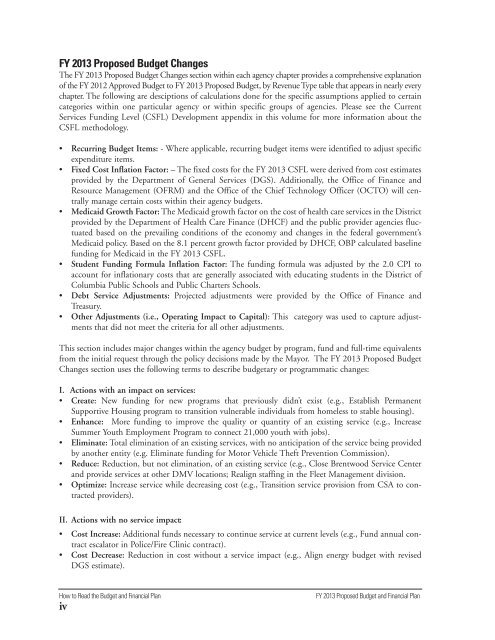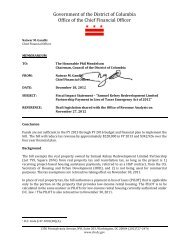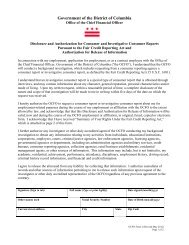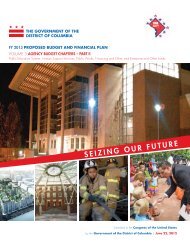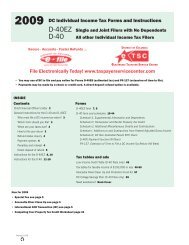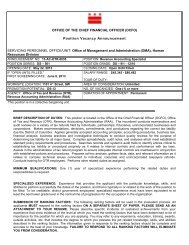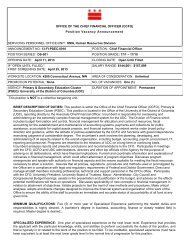Volume 1 - Executive Summary - Office of the Chief Financial Officer
Volume 1 - Executive Summary - Office of the Chief Financial Officer
Volume 1 - Executive Summary - Office of the Chief Financial Officer
Create successful ePaper yourself
Turn your PDF publications into a flip-book with our unique Google optimized e-Paper software.
FY 2013 Proposed Budget Changes<br />
The FY 2013 Proposed Budget Changes section within each agency chapter provides a comprehensive explanation<br />
<strong>of</strong> <strong>the</strong> FY 2012 Approved Budget to FY 2013 Proposed Budget, by Revenue Type table that appears in nearly every<br />
chapter. The following are desciptions <strong>of</strong> calculations done for <strong>the</strong> specific assumptions applied to certain<br />
categories within one particular agency or within specific groups <strong>of</strong> agencies. Please see <strong>the</strong> Current<br />
Services Funding Level (CSFL) Development appendix in this volume for more information about <strong>the</strong><br />
CSFL methodology.<br />
• Recurring Budget Items: - Where applicable, recurring budget items were identified to adjust specific<br />
expenditure items.<br />
• Fixed Cost Inflation Factor: – The fixed costs for <strong>the</strong> FY 2013 CSFL were derived from cost estimates<br />
provided by <strong>the</strong> Department <strong>of</strong> General Services (DGS). Additionally, <strong>the</strong> <strong>Office</strong> <strong>of</strong> Finance and<br />
Resource Management (OFRM) and <strong>the</strong> <strong>Office</strong> <strong>of</strong> <strong>the</strong> <strong>Chief</strong> Technology <strong>Office</strong>r (OCTO) will centrally<br />
manage certain costs within <strong>the</strong>ir agency budgets.<br />
• Medicaid Growth Factor: The Medicaid growth factor on <strong>the</strong> cost <strong>of</strong> health care services in <strong>the</strong> District<br />
provided by <strong>the</strong> Department <strong>of</strong> Health Care Finance (DHCF) and <strong>the</strong> public provider agencies fluctuated<br />
based on <strong>the</strong> prevailing conditions <strong>of</strong> <strong>the</strong> economy and changes in <strong>the</strong> federal government’s<br />
Medicaid policy. Based on <strong>the</strong> 8.1 percent growth factor provided by DHCF, OBP calculated baseline<br />
funding for Medicaid in <strong>the</strong> FY 2013 CSFL.<br />
• Student Funding Formula Inflation Factor: The funding formula was adjusted by <strong>the</strong> 2.0 CPI to<br />
account for inflationary costs that are generally associated with educating students in <strong>the</strong> District <strong>of</strong><br />
Columbia Public Schools and Public Charters Schools.<br />
• Debt Service Adjustments: Projected adjustments were provided by <strong>the</strong> <strong>Office</strong> <strong>of</strong> Finance and<br />
Treasury.<br />
• O<strong>the</strong>r Adjustments (i.e., Operating Impact to Capital): This category was used to capture adjustments<br />
that did not meet <strong>the</strong> criteria for all o<strong>the</strong>r adjustments.<br />
This section includes major changes within <strong>the</strong> agency budget by program, fund and full-time equivalents<br />
from <strong>the</strong> initial request through <strong>the</strong> policy decisions made by <strong>the</strong> Mayor. The FY 2013 Proposed Budget<br />
Changes section uses <strong>the</strong> following terms to describe budgetary or programmatic changes:<br />
I. Actions with an impact on services:<br />
• Create: New funding for new programs that previously didn’t exist (e.g., Establish Permanent<br />
Supportive Housing program to transition vulnerable individuals from homeless to stable housing).<br />
• Enhance: More funding to improve <strong>the</strong> quality or quantity <strong>of</strong> an existing service (e.g., Increase<br />
Summer Youth Employment Program to connect 21,000 youth with jobs).<br />
• Eliminate: Total elimination <strong>of</strong> an existing services, with no anticipation <strong>of</strong> <strong>the</strong> service being provided<br />
by ano<strong>the</strong>r entity (e.g. Eliminate funding for Motor Vehicle Theft Prevention Commission).<br />
• Reduce: Reduction, but not elimination, <strong>of</strong> an existing service (e.g., Close Brentwood Service Center<br />
and provide services at o<strong>the</strong>r DMV locations; Realign staffing in <strong>the</strong> Fleet Management division.<br />
• Optimize: Increase service while decreasing cost (e.g., Transition service provision from CSA to contracted<br />
providers).<br />
II. Actions with no service impact:<br />
• Cost Increase: Additional funds necessary to continue service at current levels (e.g., Fund annual contract<br />
escalator in Police/Fire Clinic contract).<br />
• Cost Decrease: Reduction in cost without a service impact (e.g., Align energy budget with revised<br />
DGS estimate).<br />
How to Read <strong>the</strong> Budget and <strong>Financial</strong> Plan<br />
iv<br />
FY 2013 Proposed Budget and <strong>Financial</strong> Plan


